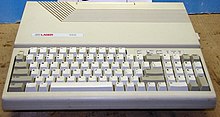Laser 128
The Laser 128 was a clone of the Apple II home computer series, which was first produced by VTech in 1984 . VTech developed his Apple-compatible ROM as a cleanroom implementation by reverse engineering , unlike the Apple II copies of Franklin . Apple Computer tried to take VTech to court and have the Laser 128 taken off the market, but failed, unlike Franklin.
As the name suggests, the laser had 128 random access memory with a size of 128 KB . Like the Apple IIc , it was a one-piece, semi-portable device with a handle and a built-in 5¼-inch floppy disk drive . In contrast to the Apple IIc, it also had a numeric keypad and an Apple IIe-compatible expansion slot. The Laser 128 was thus equipped with better expansion options than the Apple IIc. The retail price was a good 700 US dollars and was thus significantly lower than the Apple IIc.
In response to the Laser 128, Apple developed the Apple IIc + . This was followed by VTech with the Laser 128EX and the Laser EX2 .
The Laser 128 was promoted aggressively in the US by both mail order companies and retail chains like Sears . Because although its firmware did not derive directly from the Apple counterpart, the Laser 128 series was largely compatible with Apple's competing products.
This was largely due to the fact that VTech had acquired a license for AppleSoft BASIC from Microsoft , just as Apple had done before. Since it was part of Microsoft's policy to keep the rights to their software and Apple had failed to conclude an exclusive distribution agreement for Applesoft BASIC, VTech was also able to acquire a license. Much of the Apple Software was based on various Assembler - routines forming part of the BASIC in ROM constituted. It is very likely that the laser would not have been as successful if it had not had compatible ROM entry points.

